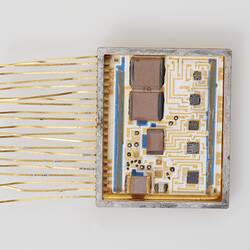Summary
Alternative name: Bionic Ear
Demonstration model cochlear implant, Nucleus, manufactured by Cochlear Limited. A cochlear implant is a surgically implanted electronic device that provides a sense of sound to a person who is profoundly deaf or severely hard of hearing. The cochlear implant is often referred to as a bionic ear.
A tiny electrode array is implanted inside the cochlea, where the hearing nerves are. A processor attached to the outer ear picks up sounds and converts them to digital code. This code is transmitted to the electrode array implanted inside the cochlea. The implant's electrodes stimulate the cochlea's hearing nerve which sends the impulses to the brain where they are interpreted as sound.
Cochlear implants developed originally by Professor Graeme Clark in Australia have now been successfully commercialised and sold worldwide. Local innovation in this technology continues with the development of other devices such as the bionic eye and brain implants for people with diseases such as epilepsy.
Cochlear now sells cochlear implants internationally and in 2013 they sold a record-breaking 26,674.
Physical Description
Plastic and titanium implant with circular end narrowing to two short cords. One cord is a Contour Advance Electrode and is tightly curled at the end; the other is a Straight Electrode. Incased inside a plastic case for display purposes with a black plastic base.
More Information
-
Collection Names
-
Collecting Areas
-
Acquisition Information
Donation
-
Manufacturer
Cochlear Pty Ltd, 14 Mars Road, Lane Cove, Greater Sydney, New South Wales, Australia, 2013
-
Lead Researcher
Professor Graeme M. Clark AC - University of Melbourne (The), Melbourne, Victoria, Australia, 1978
-
Inscriptions
On front of implant: Nucleus / Cochlear / AUSTRALIA CI00000 On back of implant: DEMO
-
Model Name or Number
-
Brand Names
-
Classification
-
Category
-
Discipline
-
Type of item
-
Overall Dimensions
135 mm (Length), 29 mm (Width), 8 mm (Height)
Dimensions of plastic case: L: 168; W: 73; H: 18mm
-
References
[Link 1] Prof Robert Shepherd, Head of the Bionics Institute, talks about the potential of medical bionics in a short film on the Think Ahead website. [Link 2]
-
Keywords
Disabilities, Ears, Hearing Aids, Hearing Impaired, Australian, Prosthetics, Innovation & Design

